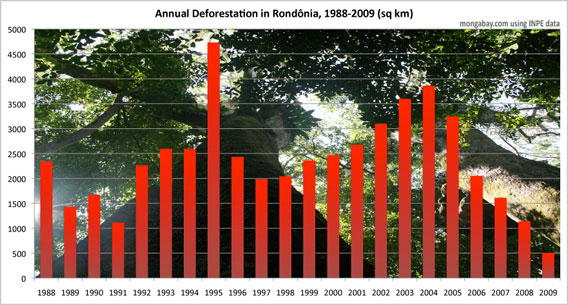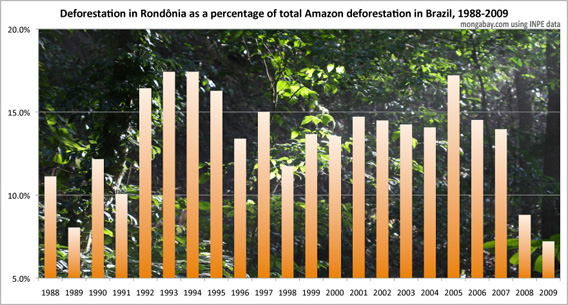Small-scale farmers who lease land from the Brazilian government are very much responsible for deforestation in the Brazilian state of Rondonia in the Amazon area. In most areas with agrarian projects, more than fifty percent of the land has been cleared of forests, while the Brazilian Forestry Code permits farming concerns in the Amazon to clear only twenty percent of the land.
This conclusion is reached by Luciana de Souza Soler, Dutch PhD student in the Land Dynamics Group at the University of Wageningen, who juxtaposes remote sensing data and information from company interviews to obtain a good picture of deforestation in the federal state of Rondônia. Since the 1970’s, small farmers have been assigned land with average sizes of a hundred hectares by the Institute for Colonization and Land Reform (INCRA) as part of agriculture projects. Soler examined land use by farming concerns in 2000 and in 2008.
Deforestation on agriculture project land in these eight years rose by an average of 62 to 78 percent. Deforestation outside these agrarian projects rose from 27 to 40 percent. The latter areas are mostly occupied by medium-sized farmers (240 – 1000 hectares) and large-scale farmers (more than a thousand hectares). The big farmers outside the agriculture development areas generally take away big slices of the rainforest, but because they are widely dispersed, there are more forests remaining in these areas. According to the Forestry Code, farmers in the Amazon area are permitted to clear only twenty percent of the forest on their land.

Annual deforestation in Rondonia, a state in the Brazilian Amazon, from 1988-2009 according to data from INPE.

Annual deforestation in Rondonia as a share of the total deforestation in the Brazilian Amazon from 1988-2009, according to data from INPE. Presented by mongabay.com. Click images to enlarge.
Biting off
Soler differentiates between old and new agriculture projects, and has established that more deforestation takes place at the start of the projects. As the projects progress, farmers keep biting off smaller pieces of the forest, especially to link the separate pieces of farmland. Rondônia has in the meantime become a major milk producer in Brazil. Farms here also supply calves to the meat processing industry.
The speed of deforestation is slowing down, says Soler. Large parts of Rondônia have already been designated as agriculture terrain or forest reserves. ‘The possibilities for expansion decrease due to limits set on public space.’ In contrast to other areas in the Amazon, illegal wood cutting by speculators is not of great consequence in deforestation, concedes Soler.
Major forces
Farmers are the major forces behind deforestation. They have to cut down trees at the start of projects to show the INCRA that they are going to rear livestock. Many farmers still feel that they should be allowed to use all their land for agriculture, since forest reserves have already been designated. ‘The Forestry Code is no longer realistic for Rondônia’, says Soler. ‘It is more realistic to maintain twenty percent of forest within the projects.’
Enforcing regulations has turned out to be difficult in practice. Soler therefore supports a new policy in which farmers have to report the percentage of forests in their land to the government. If inspections can verify this percentage, the government can extend agriculture subsidies to the companies on the condition that they put a stop to deforestation. Should the companies violate this agreement, they would have to give up the subsidy and pay a fine. Such an approach would be in keeping with farmers’ wishes to intensify their production, says Soler, and at the same time, enable the remaining forest areas to stand a better chance of being preserved.